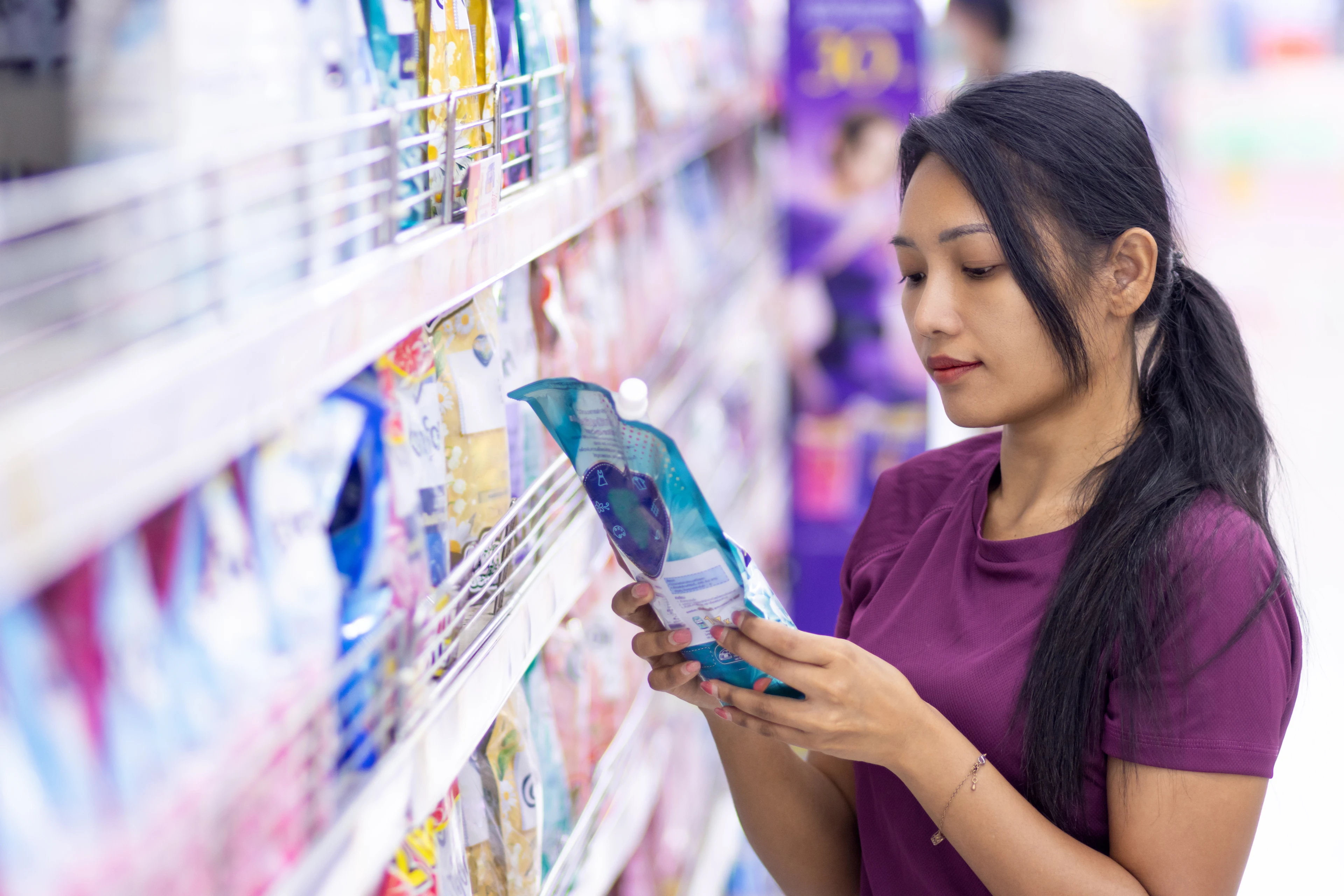17 promotional strategies to boost brand success

Table of contents
Understanding the CPG landscape: promotional strategies for today's market
Identifying and capturing promotional strategies by market
Defining promotional strategies across generations
Retaining customers with promotional strategies
Optimizing promotional strategies
TELUS Consumer Goods conducted a comprehensive survey of 1,000 consumers across the United States using TELUS Decision Insight's DecisionVelocity™ custom digital platform to uncover CPG industry trends. The resulting whitepaper, "The power of trade promotions," offers a rich source of information, insights and actions manufacturers can take to help drive margin growth. This blog post explores a few key sales promotions strategies uncovered in the whitepaper.
Understanding the CPG landscape: promotional strategies for today's market
How economic sensitivity is changing consumer behavior
In today’s market, economic concerns are shaping the way consumers shop, with nearly half (47%) actively searching for better deals on everyday items1. This shows how crucial it is for manufacturers to have competitive pricing strategies, whether that’s promotions, rebates or private label options. In fact, 50% of consumers are regularly choosing private label products1, which are usually more affordable, forcing big-name brands to find new ways to stand out.
50% of consumers regularly choose private label products
“The power of trade promotions” white paper
The shift toward omnichannel shopping
The retail world is evolving rapidly, especially with the rise of omnichannel shopping. In the last three years, traditional grocery stores have lost market share as consumers shift to online shopping1. This trend highlights the importance of having a strong digital presence and offering a seamless shopping experience across multiple platforms. As the saying goes, meet the customer where they are.
Maximizing the impact of trade promotions
What is a promotional strategy? Trade promotions are more than just a way to boost sales—they can also drive product trials and build customer loyalty. The Food and Beverage Study conducted at TELUS has shown that 61% of consumers are likely to buy a product at full price within six weeks if they had a good experience with it during a promotion1. This means a smart promotional pricing strategy can lead to long-term customer relationships, not just short-term sales spikes.
Adapting to a changing retail environment
To thrive in today’s consumer packaged goods industry, brands need to strike a balance between offering deals and maintaining their value. The key is to adapt to changing consumer preferences while staying competitive in both pricing and quality, especially in the growing omnichannel landscape. Brands that can do this well are more likely to succeed.
To continue to grow, manufacturers need to offer value through competitive promotional strategies, maintain a strong digital presence and build long-term customer loyalty. By adapting to changing consumer behaviors and preferences, manufacturers can position themselves for success in this evolving market.

Identifying and capturing promotional strategies by market
1. Leveraging high-growth categories for brand expansion
Focusing on high-growth categories offers a great opportunity for brands to increase their market share. By targeting fast-growing segments, companies can use promotions to tap into these expanding markets and attract both current customers to try new products and new customers to engage with them for the first time. This strategy helps brands align with current consumer trends, allowing them to grow alongside these booming categories and potentially become leaders in their space.
2. Winning over consumers in low brand loyalty categories
Categories with low brand loyalty are ripe for innovative promotions. In areas where consumers aren’t committed to specific brands, creative marketing and promotions can make a big impact on purchasing decisions. Competitive trade deals, unique product offerings and fresh value propositions can help brands stand out and attract customers who are willing to try new options.
3. Strengthening brand loyalty with targeted promotions
In categories where brand loyalty is strong, promotional strategies should focus on rewarding existing customers and reinforcing brand value. What are different promotional strategies? Four effective approaches could include:
Exclusive deals: Collaborating with retailers to offer special discounts for repeat customers can clearly highlight the value of staying loyal to the brand
Limited-edition products: Offering seasonal or trendy items can keep loyal customers excited and engaged with the brand
Experiential marketing: Creating memorable marketing experiences and unexpected moments can help deepen emotional connections between the brand and its customers
Co-branded products: Partnering with restaurants to create unique menu items, like a taco made with a popular nacho chip, can extend the brand’s reach to new audiences
By tailoring promotional efforts to the specific loyalty dynamics of each category, brands can build lasting relationships with consumers while expanding their market presence. These strategies also offer plenty of opportunities to generate content, which supports marketing team efforts to stay relevant and top of mind.
Defining promotional strategies across generations
4. Crafting promotional strategies by understanding your audience
Knowing your target audience is key to creating successful promotional strategies. Our research showed that different generations have their own shopping habits, preferences and values, which affect how they respond to marketing efforts1. Understanding the specific shopping patterns between Baby Boomers, Generation X, Millennials and Generation Z can lead to greater brand affinity and higher sales.
5. Tailoring promotions to technological comfort
When planning promotions, it’s important to consider how comfortable your audience is with technology. Some people prefer traditional methods like print ads or in-store displays, while others are more likely to engage with digital marketing through social media, mobile apps or email. Matching your approach to their comfort level can make a big difference in reaching your audience effectively.
6. Recognizing different shopping journeys
Not all consumers shop the same way1. Some carefully plan their purchases, researching products before making a decision, while others are more spontaneous and may buy on impulse, influenced by in-the-moment promotions1. Understanding how your audience approaches shopping can help you design strategies that meet them where they are.
7. Value perception across generations
What consumers consider "value" varies by age group1. For some, it's all about getting the lowest price. For others, convenience, quality or alignment with personal values like sustainability matter more1. Tailoring your promotional messaging to match these different perceptions of value can make your campaigns more impactful.
8. Balancing online and offline shopping preferences
Another important factor is how your audience prefers to shop. Some enjoy the in-person experience of visiting stores1, while others prefer the convenience of online shopping1. Successful promotions often use an omnichannel approach, blending both online and offline experiences to cater to a range of preferences, and in some cases, catering to consumers who shop both online and offline.
9. Social proof and brand authenticity
Generational differences also show up in how consumers view social proof and brand authenticity1. Younger shoppers, in particular, are persuaded by influencer marketing and tend to engage more with brands that are transparent and committed to social or environmental causes1.
By understanding these generational differences and adjusting your promotional strategies accordingly, manufacturers can create campaigns that resonate with a target audience and lead to better results.

Retaining customers with promotional strategies
10. Strengthening customer bonds through loyalty programs
Loyalty programs are a powerful way to build strong connections with your customers. A well-designed program not only encourages repeat purchases but also provides insights into consumer behavior. By offering personalized rewards, exclusive access to new products or tiered benefits, brands can increase customer loyalty while creating a sense of community.
11. Smart pricing strategies for profitability
Staying competitive while maintaining profitability requires smart pricing strategies. Consider options like dynamic pricing, bundle offers or strategic discounts. By analyzing market trends and understanding how sensitive customers are to prices, brands can create a pricing strategy that appeals to budget-conscious shoppers without lowering brand value or cutting into profit margins.
12. Boosting sales with in-store promotions
In-store promotions are a great way to capture impulse purchases and enhance the overall shopping experience. Tactics like temporary price reductions, eye-catching displays or product demos can grab customers’ attention and encourage them to buy. When done right, in-store promotions can increase sales and make shopping more memorable, deepening your customers' connection to your brand.
Loyalty programs help create lasting bonds with customers, while thoughtful pricing can maintain a competitive edge without sacrificing profit. When paired with well-executed in-store promotions, these strategies can boost sales and enhance the shopping experience while strengthening overall brand presence.
Optimizing promotional strategies
13. Leveraging CPG consumer insights to drive better business decisions
With TELUS Consumer Goods TABS Analytics, companies can tap into powerful CPG data insights to understand consumer behavior and sales performance across different channels. By using CPG data analytics, manufacturers can uncover patterns and trends that help shape more effective promotional strategies. This data-driven approach allows for smarter decisions about product placement, pricing and marketing efforts.
14. Creating a seamless omnichannel experience
TELUS Trade Promotion Management helps brands create a smooth and connected experience for customers across both digital and physical channels. In today’s retail world, customers interact with brands in many different ways, so it's important to design promotions that work across all touchpoints. This approach also allows for real-time adjustments in pricing and more accurate forecasting of how consumers will respond to promotional activities.
15. Preventing stock-outs with AI-driven insights
Using TELUS Retail Execution’s Sales Recommendation Engine, manufacturers can avoid stock-outs by managing inventory more efficiently. This AI-powered tool gives field representatives timely, data-driven recommendations to fix potential inventory issues before they affect sales or customer satisfaction. This proactive approach to CPG analytics ensures that products are consistently available in stores, keeping customers happy and sales steady.
16. Encouraging bulk purchases with strategic promotions
TELUS Trade Promotion Optimization uses sales data and consumer behavior insights to design promotions that encourage customers to buy in larger quantities. By analyzing purchasing trends, manufacturers can create offers that drive volume buying. This not only boosts immediate sales but also helps build long-term customer loyalty and market share growth.
17. Gain more insights and start driving growth
Download “The power of trade promotions” white paper today and discover new insights to help you make better and more profitable decisions across your business.
Win over consumers with compelling promotional strategies
1 TELUS (2024). “The power of trade promotions.”
